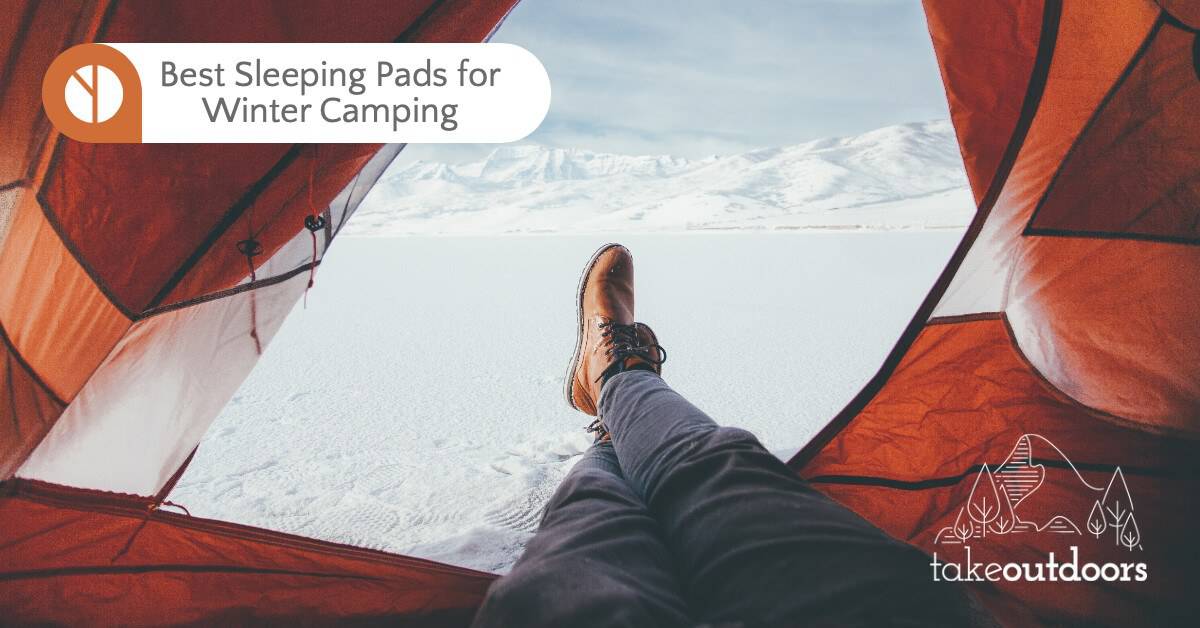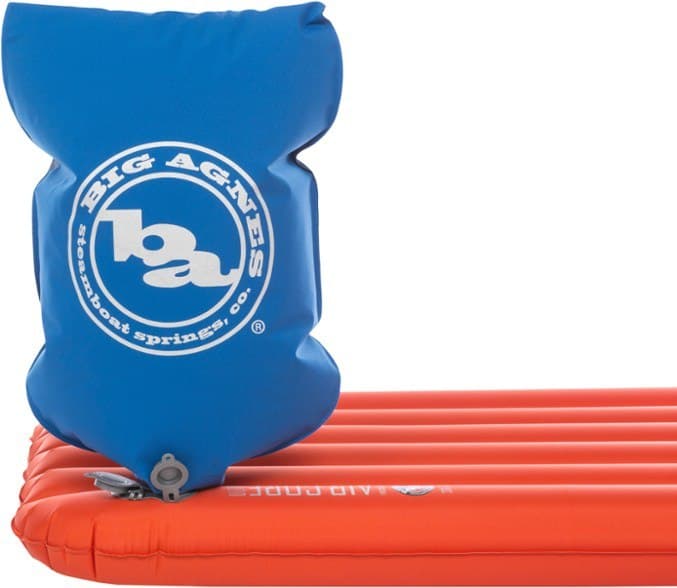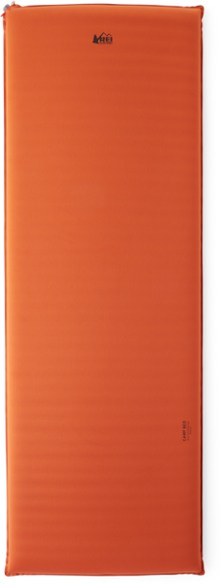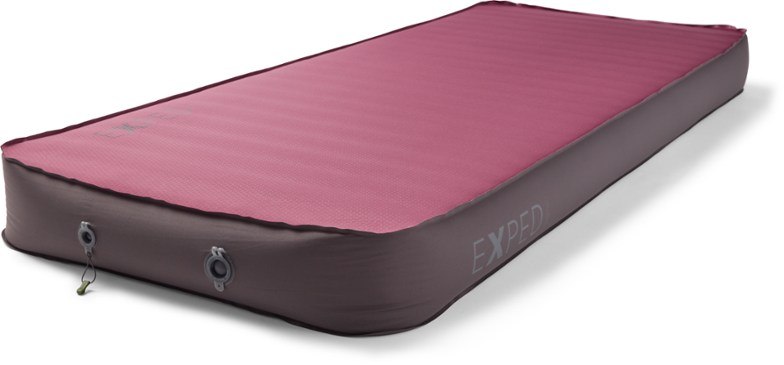We use affiliate links and may receive a small commission on purchases.
Read more about us.
Winter camping is a great way to enjoy the great outdoors during the colder months of the year. However, staying warm at night when the temperature is well below freezing requires a quality winter camping sleeping pad.
We know how hard it can be to find the right sleeping pad for winter camping, so we’ve reviewed 5 of the top models on the market today. Plus, we’ve even included a buyer’s guide complete with everything you need to know to get started.
Top Sleeping Pads for Winter Camping
Therma-a-Rest NeoAir Xtherm
- Warmth:
- Weight:
- Packed Size:
- Comfort:
- Value:
Crafted with those lightweight winter camping trips in mind, the Therm-a-Rest NeoAir Xtherm is a backpacker and mountaineer’s go-to sleeping pad for all-season use.
It boasts a respectable R-value of 6.9, making it warm enough for cold temperatures. However, this sleeping achieves a lightweight of just 15oz (425g) and a compact packed size of 4”x9” (10.2×22.9cm) as a result of its low-bulk Triangular Core Matrix construction.
Although it’s not the thickest sleeping pad around, the NeoAir Xtherm does manage to pack in a decent amount of comfort. This is thanks to its baffled internal structure, which provides ample support and stability at night.
Additionally, the latest version of this sleeping pad comes with a pump sack for easier inflation on cold evenings. It even has a WingLock valve so you can fine-tune the NeoAir Xtherm’s firmness to meet your needs.
I’ve used the NeoAir Xtherm on countless winter camping trips in the past. I’ve always been impressed by its great mix of warmth and packability. Plus, even though it’s relatively thin, I’ve found it to very comfortable in the backcountry.
Pros
- Lightweight construction for backpacking
- Highly compact packed size
- Includes a pump sack to speed up inflation
- Good warmth-to-weight ratio
Cons
- Somewhat thin construction
- Ultralight materials are prone to punctures
Big Agnes Insulated Air Core Ultra Sleeping Pad
- Warmth:
- Weight:
- Packed Size:
- Comfort:
- Value:
For a good mix of value and performance, the Big Agnes Insulated Air Core Ultra is a solid bet.
While it doesn’t boast the highest R-value, with a rating of just 4.5, the Insulated Air Core Ultra offers a good bang for your buck in the winter months. Featuring integrated Thermolite insulation and a heat-reflective film, this sleeping pad is fine-tuned to help you stay warm on chilly nights without adding too much weight to your pack.
It has Big Agnes’ proprietary I-Beam construction, which provides ample stability and back support throughout the night. The unique construction of this pad also reduces the likelihood that you’ll slide around at night.
One area where this pad really shines is in its weight to comfort ratio. Although it tips the scales at just 22oz (236.7g) and it packs down to 4”x8” (10.2×20.3cm), the Insulated Air Core Ultra is 3.25” (8.2cm) thick for added comfort as you sleep. Plus, it’s made with aviation-grade TPU laminated fabric for extra durability in rugged conditions.
I’ve tested the Insulated Air Core Ultra on quite a few winter trips and I love how wide and spacious it is. The I-Beam construction really helps provide ample back support while all that extra thickness goes a long way toward comfort at night.
Pros
- Excellent weight to comfort ratio
- Made with durable materials for long-term use
- Offers a good value for the money
- Thermolite insulation and heat reflective film for cold weather
- I-Beam construction to improve sleeping comfort
Cons
- Relatively low R-value for a winter sleeping pad
Exped DownMat XP 9
- Warmth:
- Weight:
- Packed Size:
- Comfort:
- Value:
When comfort is a top priority on a winter backpacking trip, the Exped DownMat XP 9 is hard to beat.
Featuring an impressive 7.8 R-value and a 3.5” (8.9cm) thickness, this sleeping pad is designed specifically to keep you insulated from the ground. While it’s a bit on the heavier side of things for a backpacking sleeping pad at 31.2oz, the DownMat XP 9 does pack down to just 5”x9” (12.7×22.9cm) for easier transport.
Exped built this sleeping pad with UV and abrasion-resistant ripstop polyester with welded seams, which is durable enough for frequent use. Inside the DownMat XP 9, there’s also a thick layer of down, which is interspersed among large baffles to prevent cold spots and increase your warmth at night.
Finally, the DownMat XP 9 can be easily inflated with the included Exped Schnozzel Pumpbag so you can save your breath in camp. The pumpbag also doubles as a waterproof compression sack when not in use for added versatility.
Pros
- High R-value for a backpacking sleeping pad
- Compact packed size
- Extra thick construction with down insulation
- Durable ripstop polyester with welded seams for ruggedness
- Includes a pumpbag for ease of use
Cons
- Somewhat heavy for a backpacking sleeping pad
- Expensive
REI Co-op Camp Bed
- Warmth:
- Weight:
- Packed Size:
- Comfort:
- Value:
Budget-friendly to the core, the REI Co-op Camp Bed is a comfort-focused sleeping pad for winter camping.
It boasts a respectable R-value of 7.6, which is perfect for chilly temps in the mountains. With a thickness of 2.5” (6.4cm), it’s certainly not the plushest option available, but it does have a soft stretch polyester top fabric to help reduce the likelihood that you’ll slide around on the pad at night.
The Camp Bed features a self-inflating design that reduces the amount of effort needed to set up your sleeping system each night. It also has a low-profile high-flow valve, which allows you to get the perfect amount of firmness in your sleeping pad for your unique needs.
Due to its foam core, the Camp Bed is a bit on the heavier side at 58oz, but it’s certainly well within the weight range for occasional use on backpacking trips. Moreover, this sleeping pad is made with an extra-strong 150D polyester ripstop fabric base with welded seams, so it’s affordable and durable, all in one package.
Pros
- Very affordable price for an air mattress
- Durable construction with welded seams
- Self-inflating design for ease of use
- High R-value for warmth
Cons
- Slightly heavy for backpacking use
- Somewhat thin
Exped MegaMat 15
- Warmth:
- Weight:
- Packed Size:
- Comfort:
- Value:
If wintertime car camping trips are your MO, the Exped MegaMat 15 is a luxuriously warm bed to cozy up in for the night.
Explicitly designed with comfort in mind, this oversized sleeping pad has an R-value of 10.6 and an extra-thick 6” (15.2cm) height for a superior sleeping experience. The walls of this sleeping pad are also vertical so you won’t constantly slide off at night.
While all this extra insulation and thickness does come with some bulk and weight that makes it unsuitable for backpacking, the MegaMat 15 is the perfect size to pack on roadside adventures. It also features a 50D stretch tricot nylon fabric that’s soft to the touch for added comfort as you snooze.
To ensure easy set-up, Exped created this sleeping pad with FlatValves that allow for quick and easy inflation. For even more ease of use, the MegaMat can be pumped up in seconds using the included mini pump so you can spend more time enjoying the great outdoors.
Pros
- Soft top fabric for added comfort
- Extra thick and well insulated
- Vertical walls prevent you from sliding off
- Easy to set up with included pump
Cons
- Heavy and bulky
- Expensive
Winter Camping Sleeping Pad Buyer’s Guide
Selecting a quality winter camping sleeping pad is all about knowing what to look for as you shop. So, here are some of the key things to keep in mind during the buying process.
R-Value
A sleeping pad’s R-value is a measure of how well-insulated it is. Basically, the higher the number, the warmer the sleeping pad.
For wintertime use, an R-value of 4 should be considered an absolute minimum. But, any pad with a higher R-value will be able to keep you warm in the cold.
Weight & Packed Size
Weight and packed size are important considerations for any camper, but they’re most important for backpackers. When it comes to winter sleeping pads, backpackers should opt for models that weigh less than 48oz/1.4kg (anything under 36oz/1kg is preferred) and that pack down to under 5”x10” (12.7×25.4cm) in size.
Comfort
Comfort is imperative with any sleeping pad. There are two key metrics to look for with comfort: how thick the pad is and its shape.
Thicker pads will have more cushioning and, thus, will be more comfortable at night. Additionally, rectangular models tend to be more comfortable, albeit usually heavier, because you’re less likely to fall off of them at night.
Conclusion
At the end of the day, only 1 sleeping pad will join your next winter camping trip. If we had to choose just 1 of these 5 great options, we’d go with the Therm-a-Rest NeoAir Xtherm, because it offers a good mix of warmth, packability, and value for the money. While it’s not as thick and comfortable as some other options, like the Exped DownMat XP 9, in terms of all-around versatility, the NeoAir Xtherm is a top contender.
A professional mountain guide and experienced outdoor educator, Gaby enjoys traveling and exploring the world’s most remote locales. As a writer and editor, Gaby has written for a variety of climbing and travel blogs, news sites, and climbing magazines. When she’s not writing, Gaby loves a strong double shot of espresso and hanging out with penguins in Antarctica.You can check out more of Gaby’s work on her website: www.gabypilson.com







